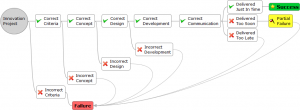95 Times More Profitable Products, Predictive Innovation Training
Learn how to use Predictive Innovation® to predict what customers will want and how to make it so that you can increase profits reduce risk, and neutralize competition.
Find new markets, create new products, increase return on investment.
In a nutshell Predictive Innovation® is a structured way to describe what people want and how to provide it. Anything that can be made or done can be described. If you can describe it you can also describe the ideal version.
The Ideal Product does What I want, When I want, Where I want, with whom I want, in the way I want, for the price I want with no hassle.
If you step backwards from the ideal to what is available today, each of those steps is an innovation. There isn’t just one straight path to the ideal, and many of those paths are dead ends. Predictive Innovation® gives you a structured way to describe the entire idea space showing you all those paths.
Describing all possible innovations:
- reduces risk
- increases profits
- maximizes return on investment
- allows you to calculate the Total Innovation Value making it easier to choose and get support for good projects
The most common approach to New Product Development is to use a Staged Gate Process starting with a huge number of ideas then filtering them down through a number of stages until what is hoped to be a successful product is launched. Despite the typical Staged Gate Process having 7 stages the failure rate of new product launches is 40%, basically random. Despite 50 years of attempts to improve Staged Gate the failure rate has remained 40%.
A study of 576 projects at 360 Fortune 500 companies revealed there was a huge difference between the results of product managers at the same companies using the same process. The bottom 1/3 had an average of $2 million profits with the 40% failure rate. The middle 1/3 had an average profit of $21 million again with the 40% failure but the top 1/3 had $189 million profits, 95 times as profitable as the bottom 1/3. Instead of a 40% failure rate they had a 96% success rate. Clearly the top 1/3 were doing something very different from the bottom and middle.
The best definition of innovation is:
Profitably satisfy unmet desires.
Profitable doesn’t just mean money. Consumers profit from using the innovation. They give money to get their desire satisfied. Businesses profit monetarily. Charities profit from doing good. Whoever is involved with an innovation all of them must benefit or it just won’t happen.
Unmet desire is one that has not yet been satisfied some other way. Innovation does something new or better. To innovate you need to know what to do, how to do it and you must do it correctly. So there are two basic types of innovation systems, thinking systems and doing systems. Staged Gate is the most common doing system. Creativity is the most common thinking system.
Creativity is unpredictable, unreliable, unfocused, inefficient, highly emotional. Its often said in brainstorming sessions to leave egos at the door which shows you how emotional it is. Creativity is also person specific depending on people with special talent. Anyone can do Predictive Innovation® without being particularly creative.
Staged Gate manages the risk but you can see that the risk is caused by using creativity for ideas. If you use a different Thinking System Staged Gate can focus on the risks of doing and achieve the 6-Sigma results you want.
The Staged Gate Process using creativity starts with a large number of ideas and filters them down. On average it takes 300 ideas to produce 1 product. That filtering process costs 9 times as much as developing a single project.
When we analyzed innovation as a process we discovered there are 7 Essential Functions to the innovation process.
Those steps are:
- Reveal emerging expectations, the things customers demand in the near future
- Generate ideas that satisfy the emerging expectations
- Convert ideas into designs
- Make new products or set up systems to perform services
- Communicate value, both internally and externally
- Deliver new product or service
- Get and use feedback that is meaningful, and start again with generating ideas
Notice that you don’t need to reveal emerging expectations again. Emerging expectations are the criteria for ideas and products. This is what to measure and the current measurement. Since in the first step you defined the emerging expectations you already know what customers will want, it is something closer to the ideal. The ideal product perfectly satisfies all the criteria for a product. Each improvement between the ideal and what is available today is an innovation. Feedback tells you how close to the ideal your product is and how much closer is needed for the next improvement to be accepted by customers.
The second step is generate ideas that satisfy the emerging expectations. There is such a thing as a bad idea. Any idea you spend time or money on that doesn’t profitably satisfy a customer’s desire is a bad idea. If you skip revealing emerging expectations then the ideas are a random mess and you end up spending huge amounts of time and money sorting and testing the ideas hoping to find a good one. If instead, you start by defining the criteria of the emerging expectations you know what customer’s will want so you can focus on generating ideas that match the criteria. Predictive Innovation® also gives you a structure for ideas so you can quickly identify the right idea and all the related ideas. This makes it possible to choose the best idea and have a sequence of future products related to that core idea.
Once you know what to make you need to know how to make it this is what you do when you Convert ideas into designs. Even if customers want an idea if you can’t profitably make it then its not a good idea for you. Being able to solve the technical challenges so that you can profitably make what customers want is essential to success.
After you have the design you must efficiently follow it. Making the product or setting up the system to perform the services is where the doing system takes over. This is where Staged Gate and other process control methods like 6 Sigma will help you the most. You will still need a thinking system to improve your process and overcome unexpected challenges and Predictive Innovation® helps you there as well.
Communicating value is really done throughout the entire process. You must get approval from stakeholders, funding for projects, and motivate workers in addition to selling to customers. The criteria revealed with the emerging expectations provides you the tools to effectively communicate value to everyone in their own language.
Innovation hasn’t occurred until the customer has the product and is using it to satisfy their desires. So you must deliver the new product. And finally you should get and use feedback from all the steps. Knowing the criteria again is essential to asking the right questions and determining how to measure the results. Without first revealing the emerging expectations the entire process suffers.
Using Predictive Innovation® changes everything. Instead of filtering down from a pile of random ideas you start with accurate criteria to build up a family of successful products. This increases profits and reduces risk at the same time.
Predictive Innovation® Overview
There are 6 dimensions to Predictive Innovation®, these are:
- Actors
- Desires
- Scenarios
- Alternatives
- Outcomes
- Elements
For Practitioner we will focus on Alternatives, Outcomes, and Elements.
Every scenario has approximately 7 outcomes and each outcomes has 7 types of elements with 15 types of alternatives. This makes the hypercube of the idea space. 15 Alternatives times 7 elements times approximately 7 outcomes produce approximately 735 types of ways to innovate for any scenario.
These are types so there can be multiples for each type but there is at least one of each type, this defines the idea space. The complete idea space must have at least one of each of the 735 types. Most products don’t properly satisfy one or more outcomes and only cover 3 elements with 1 Alternative. This means that less than 1% of the idea space is covered by most products. That leaves a huge amount of space available for innovation.
By not covering the entire idea space a large amount of the possible profits are ignored. Most products cover less than 1% of the idea space and only 13% of the idea space is even explored. This is a huge area of missed opportunity.
That ignored space is not only missed opportunity it causes risk. That unexplored region is open to competition, might have easier higher profit ideas that better satisfy customers desires. If you remember the difference between the profitability of the different project managers its very close to the same ratio. The reason the top 1/3 of product managers are 95 times as profitable is because they reduce the risk and increase the opportunities by covering the entire idea space.
Conclusion
Describing all possible innovations:
- reduces risk
- increases profits
- maximizes return on investment
- allows you to calculate the Total Innovation Value making it easier to choose and get support for good projects
Tags: <business strategy, how to innovate, increase profits, increase return on investment, increase roi, innovation education, innovation trainning, innovation workshop, marketing, neutralize competition, new product development, npd, reduce risk, Staged gate>
Staged Gate accepts failure instead of ensuring success
Innovation projects have many risks. Some of these risks are controlled with project management techniques. Other risks are assumed unavoidable. Staged Gate attempts to limit the impact of the risks by setting up regular intervals to fail and start over. That is a fancy way of saying trial and error. Predictive Innovation® can prevent the failures, thus saving time and money.
Projects like constructing a building have well known steps. Budgets and schedules can be accurately estimated because the tasks have been performed before. Innovation projects always deal with some aspect that has never been done before. That newness introduces two types of risk, first is what to do and second is how to do it. This breaks down into 6 mandatory sequential outcomes. All 6 must be completed successfully for the innovation project to succeed.
 Read more
Read more
Why do 88% of Ideas Fail to Make it to Market?
The reason 88% of ideas fail to make it to market is companies have no system to turn ideas into marketable innovations.
Even though 87% of CEOs list innovation as a Top 5 priority 78% of companies have NO INNOVATION SYSTEM.

Do you think it’s a coincidence that 88% of ideas fail to make it to market when 78% of companies lack any innovation system?
Innovations produce 300% larger return on investment than capital investments. You can clearly see why CEO’s list innovation as a top priority. Innovation is the best source of profits.
Why don’t more companies have an innovation system?



 Predictive Innovation Training
Predictive Innovation Training Predictive Innovation: Core Skills Book
Predictive Innovation: Core Skills Book RoundSquareTriangle.com
RoundSquareTriangle.com